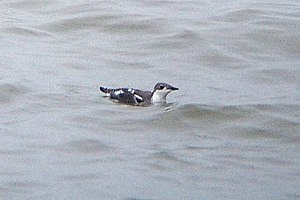Kamchatka Marmelalk
| Kamchatka Marmelalk | ||||||||||
|---|---|---|---|---|---|---|---|---|---|---|

Kamchatka Marmelalk ( Brachyramphus perdix ) |
||||||||||
| Systematics | ||||||||||
|
||||||||||
| Scientific name | ||||||||||
| Brachyramphus perdix | ||||||||||
| ( Pallas , 1811) |
The Kamchatka Marmelalk ( Brachyramphus perdix ), also known as the long-billed alkali , is a monotypical species from the family of the alken birds. The species has long been considered a subspecies of the Marmelalk , which occurs on the North Pacific coast from the Aleutian Islands to California, while the Kamchatka Marmelalk is common from Kamchatka to Hokkaido. Findings based on mtDNA and allozymes showed, however, that this is more closely related to the short-beaked lalk and that the Kamchatka marmelalk is a sister species of the two. All three species are very closely related, however, the split into different species occurred within the last two to three million years.
Similar to the marmelalk and the short-beaked lalk, the Kamchatka marmelalk exhibits unusual breeding behavior for alkenbirds. It usually breeds in ancient forests deep inland. The exact numbers are not known. However, among the three species in the genus Brachyramphus , it is considered to be the least endangered. The IUCN currently classifies the species as near threatened .
Appearance
The Kamchatka Marmelalk reaches a body length of 25 centimeters. It is therefore a very small alken bird, but it is about 20 percent heavier than the Marmelalk. The legs sit very far back on the body, so that the species only moves clumsily on land. Swimming Kamchatka jellyfish point with their beak upwards, the tail protrudes far out of the water and is usually erect. The bill is black and pointed. Compared to the very similar Marmelalk, the beak is longer. Flying Kamchatka Jamalks have a very fast wing beat frequency.
In its splendid dress , the Kamchatka Marmelalk is white with dense black-brown spots. It has a lower red-brown proportion than the Marmelalk. The simple dress is black and white, the black head color extends over the eye. The neck, torso and upper wing-coverts are dark, it lacks the indistinct neck band that is characteristic of the Marmelalk. Kamchatka hawks have a small white spot behind the eye, which is a little more pronounced than with hawks.
distribution
The Kamchatka marmelalk is a breeding bird in the North Pacific. Its breeding area extends along the coasts of the Sea of Okhotsk , the Kamchatka Peninsula and Sakhalin to Hokkaido, where this species breeds occasionally. During the winter months, the more northerly breeding birds move south to avoid the sea ice.
Kamchatka marmalarks are more often observed far outside their range. There are confirmed observations in North America from Florida, Pennsylvania, New Jersey, New York, Massachusetts and Newfoundland, among others. The individual found in a fishing net in Lake Zurich in December 1997 is probably a Kamchatka Marmelalk. The bellows is now in the Natural History Museum Basel . A second, living individual appeared in early November 2006 in Devon, England and was observed there for several days.
Reproduction
Similar to the Marmelalk, the Kamchatka Marmelalk is a predominantly tree-breeding species. It uses very old trees as a nesting tree. The nest is in the upper part of the tree on a thick branch. The breeding grounds of the Kamchatka marmelalks are often very far inland. The breeding season is about a month, the young bird is fed by the adult parent birds for about a month. The young bird finds its way to the sea without the support of the parent birds.
Existence and threat to existence
There are no inventory figures for the Kamchatka Marmelalk. The IUCN assumes, however, that tens of thousands of birds of this species still exist: while the Kamchatka marmelalk is a rare bird on the coast of Hokkaido, it is more numerous on the coast of the Sea of Okhotsk. There are several regions in Russia where the species is even considered to be relatively common. These include the Amur estuary and the Kamchatka Peninsula. The species is much rarer in the Sakhalin region.
The deforestation of old forest stands is one of the factors that endanger the survival, which is increasingly taking place on Sakhalin and Kamchatka in particular. The species is also endangered by oil pollution.
supporting documents
literature
- Anthony J. Gaston, Ian L. Jones: The Auks (= Bird Families of the World. Vol. 4 (recte 5)). Oxford University Press, Oxford et al. 1998, ISBN 0-19-854032-9 .
Single receipts
- ↑ Hans-Günther Bauer, Einhard Bezzel , Wolfgang Fiedler (eds.): The compendium of birds of Central Europe. Everything about biology, endangerment and protection. Volume 1: Nonpasseriformes - non-sparrow birds. 2nd completely revised edition. Aula-Verlag, Wiebelsheim 2005, ISBN 3-89104-647-2 , p. 572.
- ↑ BirdLife Factsheet on the Kamchatka Jamelalk , accessed on October 17, 2010
- ↑ Gaston et al., P. 191
- ↑ Gaston et al., P. 194
- ↑ Hans-Günther Bauer, Einhard Bezzel , Wolfgang Fiedler (eds.): The compendium of birds of Central Europe. Everything about biology, endangerment and protection. Volume 1: Nonpasseriformes - non-sparrow birds. 2nd, completely revised edition. Aula-Verlag, Wiebelsheim 2005, ISBN 3-89104-647-2 , p. 573.
- ↑ BBC News of November 11, 2006 , accessed October 17, 2010
- ↑ BirdLife Factsheet , accessed October 17, 2010
Web links
- Brachyramphus perdix inthe IUCN 2013 Red List of Threatened Species . Listed by: BirdLife International, 2012. Retrieved January 14, 2014.